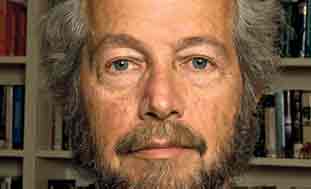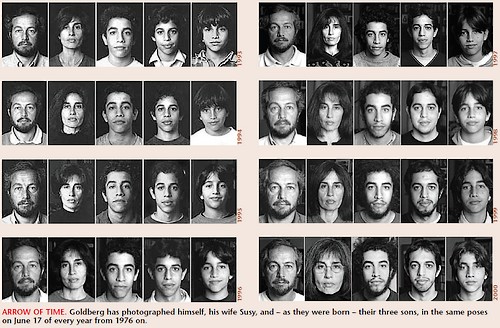| A lifetime project captured on film |
 |
| Written by David Brinn |
|
Each year, on June 17, Diego Goldberg readies his Nikon D700 camera to take the annual family photos – he has been doing this now for 33 years.
Studying the black-and-white portraits in Diego Goldberg’s time-lapse photo journal Arrow of Time, one can’t help marvel at the changes a person undergoes during a lifetime.
Surely, there must have been some underlying, philosophical message about life, death and aging that the Argentinean photojournalist was trying to in undertaking the 33-year, award-winning project that entailed photographing himself, his wife Susy, and – as they were born – their three sons, in the same poses on June 17 of every year from 1976 on.
But ironically, like so many inspired works of art, the impetus behind the project was much more mundane – Goldberg’s mother-in-law asked him for a nice portrait of the couple to hang on her bedroom wall.
“June 17 happened to be the first anniversary of our living together, and I did a very simple photo of Susy and myself. The following year, as that anniversary came along, I said, let’s take another photo to see how we changed. From there it took off and we never stopped,” said the 63-year-old resident of Buenos Aires during a phone conversation last week.
Despite its modest beginnings, Arrow of Time (at http://www.zonezero.com/magazine/essays/diegotime/time.html), like those well-known time lapse photographs showing a flower blooming or a building being erected, encapsulates the effect of time in a concentrated fashion, proving beyond doubt that a picture is indeed worth volumes of description.
Especially striking is the juxtaposition of Diego and Susy – as they transform like Dustin Hoffman in Little Big Man from young, dark-haired, unlined 30-year-olds to stately sexagenarians with thinning hair and rings under their eyes – and their children, Nicolas, Matias and Sebastian, who grow from precious infants into bushy, hairy adults.
The photos are really arrows of time, preventing – if only for the second of a shutter snap – time from passing by, and capturing the Goldberg family in a moment as they wave to each other on the up and down escalators of life. As The Rolling Stones once sang, “Time waits for no one, and it won’t wait for me.” But even after that second year of photographs, Goldberg didn’t realize that he had struck upon a lifetime project.
“As the years went by, it sort of took on a life of its own and turned into something we can’t stop. At first, it was our project, now we belong to the project,” said Goldberg, explaining the longevity and perseverance the family has displayed. “The kids all loved the idea of it, and even when they were little, they never complained when the day came, they looked forward to it.”
Goldberg, like any photographer worth his lens, doesn’t attempt to offer any profound messages or discoveries that may be conveyed by the photos, which were awarded the Gold Medal at the Society of Publications Design Annual Awards competition and the Distinguished Achievement Award at the 1998 Art Directors Club of New York annual contest. Instead, he prefers to focus on the images themselves.
“I try not to be too philosophical or metaphysical about what it means. I guess the most striking thing for me is how the kids change. Obviously Susy and I change, but seeing kids being born and developing into young men is the interesting thing for me in terms of my family,” he said.
That’s perhaps because Goldberg was away from home so often during his sons’ childhood. Over a diverse 35-year career as a photojournalist while living in Buenos Aires, New York and Paris, he’s traveled around the world shooting some of the era’s most historic moments, including the Nicaraguan revolution, Egyptian president Anwar Sadat’s historic visit to Israel, the Malvinas (Falkland Islands) war and personalities as diverse as popes, president Ronald Reagan, French president François Mitterrand and Argentinean president Carlos Menem.
“Did Sadat’s visit to Israel feel historic? Oh yeah, it was extraordinary, and it was historic for me too. My photo got on the cover of Newsweek,” said Goldberg, who calls himself a fully secular Jew.
“I haven’t been back to Israel since then, and I don’t really feel any special connection to Israel or to Judaism. I don’t think I’ve ever photographed anything with a specific Jewish theme,” he said, adding that he and his family never experienced any kind of discrimination in Buenos Aires and consider themselves fully integrated Argentineans.
Besides his work in Newsweek and major publications like Time, L’Express, Stern and dozens of others, Goldberg has also taken part in all of the volumes of the famous Day in the Life series, and photographed for a number of books including Nicaragua – A Decade of Revolution and Passage to Vietnam. Not a bad resumé for a one-time physics student who was one class away from becoming an architect.
“I studied two years of physics and then architecture for five years, but I was always taking photos as a hobby,” said Goldberg. “As I was getting more involved with my studies, I realized one day that I didn’t see myself being an architect, and what I really wanted to do was travel the world as a photojournalist. So just before I graduated, I had abandoned architecture for photojournalism. I didn’t have any experience, but I just jumped in and did it.”
After traveling for much of his career, Goldberg stayed put in Buenos Aires from 1996 to 2003 as the photo editor for Argentine newspaper Clarin, with the largest circulation of any Spanish-language paper, leading the photo department to the prestigious Visa D’Or Prize at the Perpignan Photojournalism Festival.
Looking to expand beyond daily journalism, Goldberg left the paper and wound up working on one of his main photographic achievements – a one-man show at the United Nations General Assembly in 2005 called Chasing the Dream, which chronicled the struggles and the hopes of eight youngsters from Brazil, Cambodia, India, Jamaica, Uganda, Morocco and other nations.
“After I left Clarin, I got together with a friend who was a journalist and started thinking about long-term projects together. We heard that the UN was calling for proposals to illustrate its Millennium development goals ahead of a meeting of world leaders. We decided to submit a proposal which we felt had an original approach. And it was accepted,” said Goldberg.
“We wanted to get away as much as possible from the usual NGO style of smiling minority kids and generalizations, and focus instead on illustrating each goal through the life of one child – whether it be hunger, maternal care, HIV. We traveled to eight countries for eight different children.”
For Chasing the Dreams, Goldberg was awarded a $25,000 prize from the FNPI Foundation, which joined the many other prizes and honors he’s earned over his years as a photojournalist.
Even though he’s out of the news photography world, he still recalls the adrenaline rush and urgency of rushing off to cover a cataclysmic event – like the recent earthquake in Haiti.
“It used to be my first instinct to hop on a plane when something like that happened. I don’t really have that urge anymore. It’s not that I’m not interested in breaking news, the flame is still there, but I’d rather do more long-term projects,” said Goldberg, adding that he’s not like some photographers who need to pick up a camera every day.
“Even when I was working for papers, I didn’t take pictures every day. I traveled so much when I was freelancing. I’d be shooting for two days straight or three weeks, and then I’d go back home and be with the family and not pick up a camera for a while.”
But when June 17 comes around, Goldberg is ready with his Nikon D700 camera to take the annual family photos. He began shooting Arrow of Time with an old Nikon camera and over the years has used upgraded models and moved into the digital photography realm.
“We started on film and somewhere along the way started doing it digitally. I’m using both now, still shooting the film to keep up the tradition and to have everything on film, just in case,” he said, adding jokingly that he resists the urge to digitally touch up the lines around his face.
Even though he’s reluctant to enter into a philosophical discussion about the impact of the photos, Goldberg readily recounts the impact that Arrow of Time has had on viewers who have contacted him since it first appeared on-line.
“What amazes me is that it’s such a simple idea that anybody can do, and the fact that nobody seemed to have thought about doing it before is really weird. It’s so simple, and at the same time, so strong,” he said.
“I get thousands of e-mails from all over the world, and what half of the people write is ‘how I didn’t think of that? Now it’s too late.’ The other half write that it was so inspiring that they’re going to do it also when they get married or when they have kids. That’s easy to say, but I don’t know if they’ll have the same perseverance.”
That determination isn’t likely to dissipate when Goldberg eventually lays down his camera.
“My oldest son, Nicolas, is a photographer and I’m sure he’ll continue the project after me,” said Goldberg. “He has his own daughter now, so we’re starting to develop a tree instead of just one trunk – there are different branches starting to appear.”
by David Brinn
|






